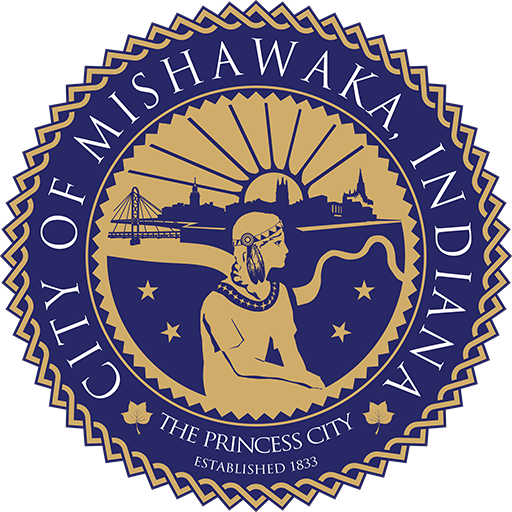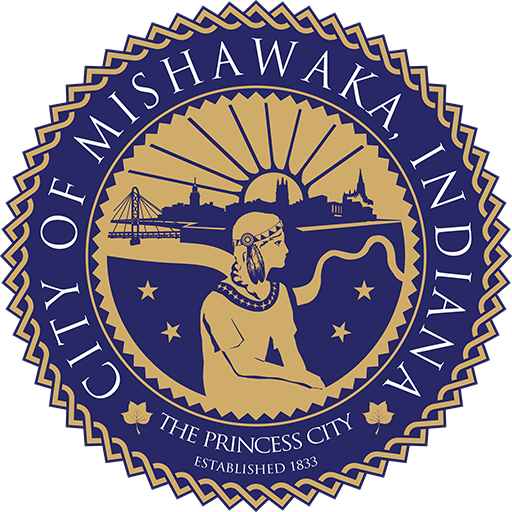Mishawaka's Historical Markers
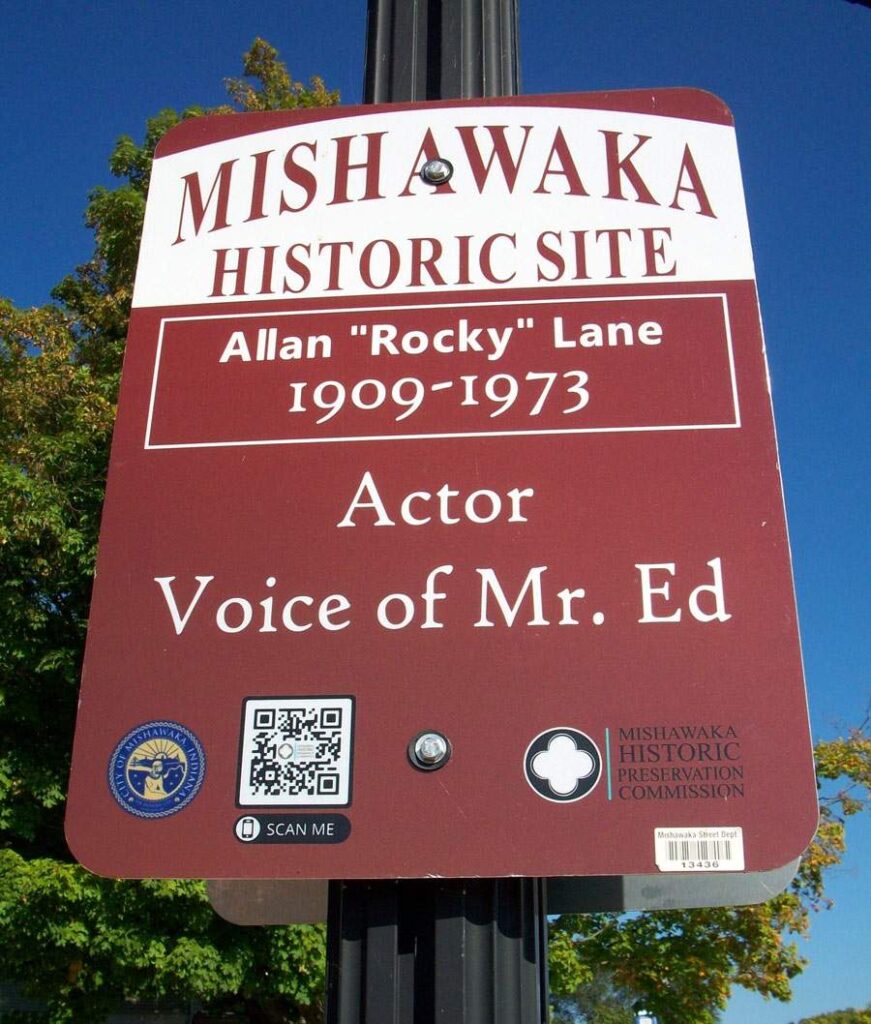
Allan “Rocky” Lane - 224 East Mishawaka Avenue
Allan “Rocky” Lane was known to moviegoers of the 1940s and ’50s as one of Hollywood’s biggest Western stars. Born in Mishawaka in 1909, Harry Leonard Albershart lived in Mishawaka until at least 1919 and later moved with his mother to Grand Rapids, Michigan. Harry began acting on stage in 1925 and toured the country in productions before landing a small role in a 1928 silent picture, the first of 125 film credits. The next year he assumed the screen name Allan Lane and had small parts in more movies before leaving for Broadway. Allan gave up acting in 1932 and ran his own advertising agency in New York City. Lane resumed his film career in 1936 and appeared in dramas and comedies during the late 1930s. The beginning of Lane’s career in Westerns was King of the Royal Mounted (1940). By 1943, Lane was known as a lead actor and was soon steadily doing Westerns. He took on the role of Red Ryder in seven movies during 1946-1947. The Wild Frontier (1947) was the first of 39 films in which he played “Rocky” Lane, a lawman who upheld justice and defended the good folk of the West. El Paso Stampede (1953) was his last movie as Rocky Lane. The role that would become Lane’s greatest Hollywood legacy began in 1961 when he provided the voice for a talking horse in Mr. Ed, a television sitcom which ran for five seasons. Allan Lane died in Los Angeles in 1973.
Bethel University - 1001 Bethel Circle
Since Bethel University’s founding in 1947, students from around the world have come to its Mishawaka campus to grow their faith and to earn a degree at this Christian liberal arts university. In 1944, the Mennonite Brethren in Christ approved the creation of a college for the denomination’s young people, and a 40-acre campus was purchased on the northwest edge of Mishawaka two years later. Twenty-seven-year-old Woodrow Goodman was the school’s first president. Bethel College opened for its first 94 students on September 15, 1947. Several existing structures on the campus were used by the college, and an administration building was completed in 1951. “With Christ at the Helm” was the school’s motto. During the 1950s, Bethel’s enrollment grew, and more academic programs were established. Intercollegiate athletics were approved in 1958, and Bethel’s first basketball game was played in 1959. The student body grew to 531 by 1966, and several new buildings were added to the campus in the 1960s. Bethel received North Central Association accreditation in 1971. After dropping to 411 students in 1988, Bethel entered a period of sustained growth under the presidency of Dr. Norman Bridges (1989-2004). Enrollment increased to 1,850 students, numerous academic and athletic facilities were built as part of an attractive plan for the 75-acre campus, and many new degree programs were created. Bethel Pilots athletic teams have excelled, winning more than 40 N.A.I.A. and N.C.C.A.A. national championships. To reflect its graduate degree programs, Bethel changed its name to Bethel University in 2019.
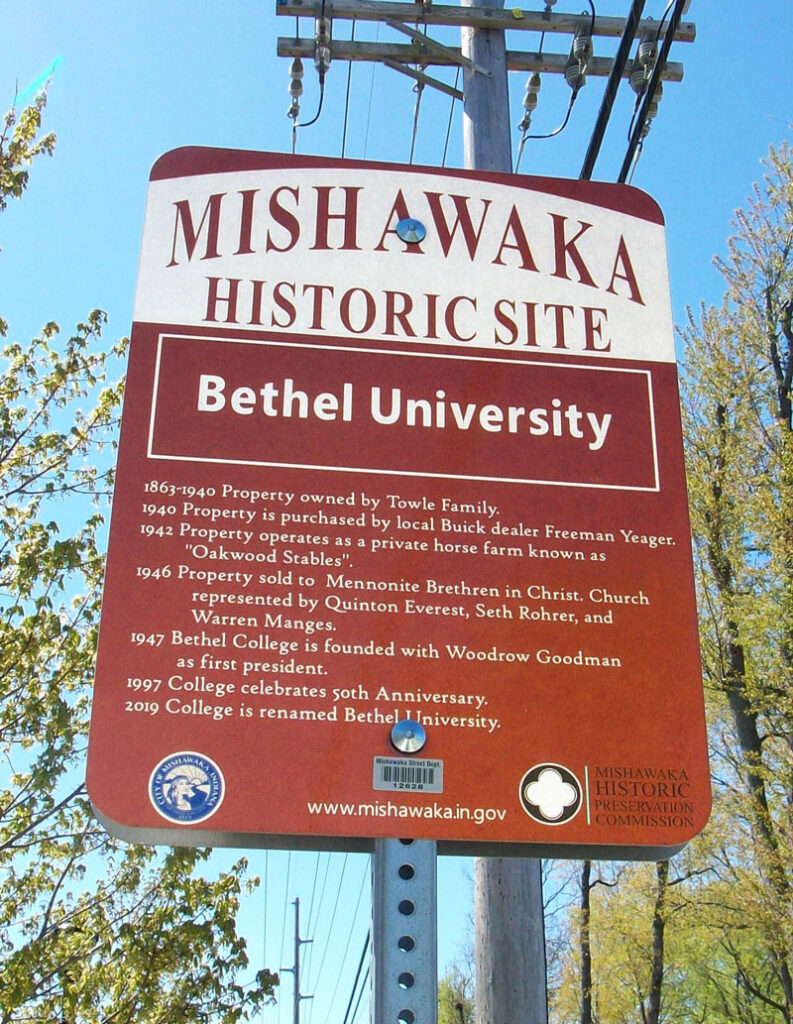
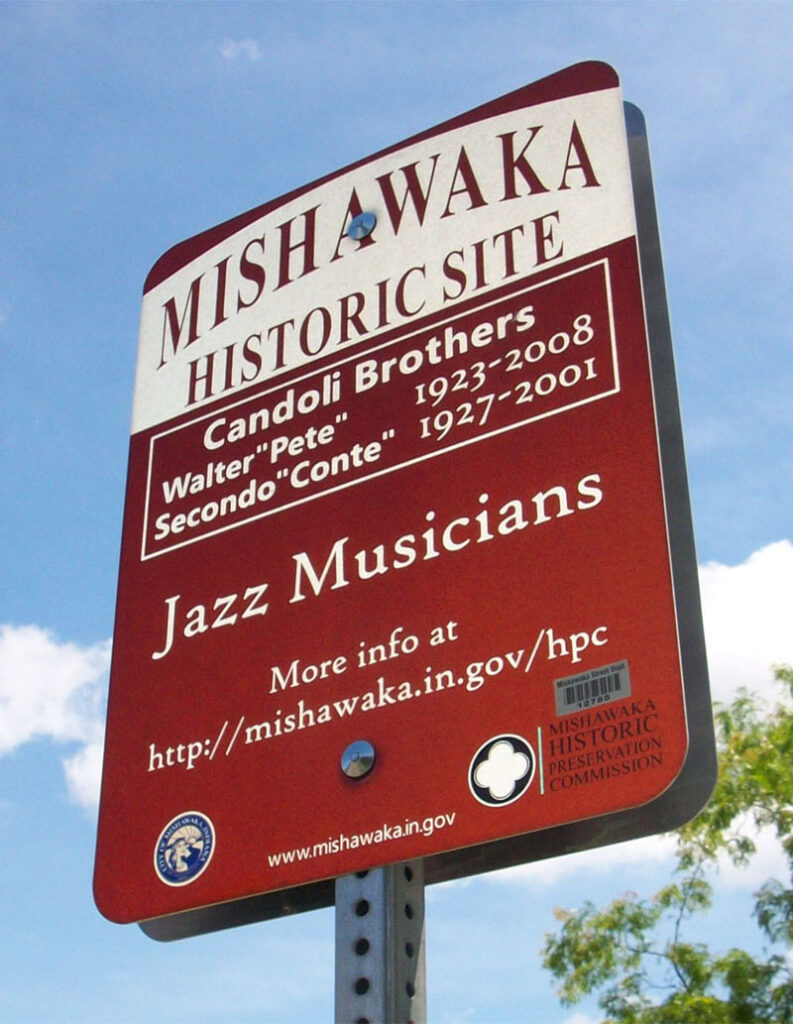
Candoli Brothers - 404 West Eleventh Street
Brothers Pete and Conte Candoli have put Mishawaka on the musical map as the birthplace of two of the greatest jazz trumpeters. Pete was born in 1923 and attended Mishawaka schools but did not graduate from Mishawaka High. At age 18, he joined the Sonny Dunham Orchestra and later performed with other bands, including the Tommy Dorsey Orchestra and Woody Herman’s First Herd. Pete’s musical range and endurance amazed other performers, who dubbed him “Superman with a horn.” Pete moved to Los Angeles in 1955 and became a studio musician. He also appeared with various bands, released numerous albums, and performed in jazz festivals and concerts around the country and overseas. Conte was born in 1927. Upon graduation from Mishawaka High in 1945, he joined Herman’s band until being drafted into the U.S. Army. After returning to civilian life in 1946, Conte joined Chubby Jackson’s Fifth Dimensional Jazz Group and then the Stan Kenton Orchestra before forming his own band, which later became the Candoli Brothers. Conte moved to Los Angeles in the mid-1950s, recorded with the era’s biggest stars, and performed concerts with jazz’s top talents. Starting in 1967, Conte occasionally appeared on The Tonight Show with Johnny Carson as a member of Doc Severinsen’s N.B.C. Orchestra and was a regular from 1972 until 1992. Conte and Pete were inducted into the International Jazz Hall of Fame in 1997. Conte died in Palm Desert, California, in 2001, and Pete died in Studio City, California, in 2008.
Capt. Richard C. Brenneman - 1801 East Third Street
The most celebrated serviceman from Mishawaka during the Vietnam War was Capt. Richard Brenneman, a U.S. Air Force pilot who was shot down over North Vietnam. Brenneman was born in Mishawaka in 1942 and graduated from Mishawaka High in 1960. He joined the Air Force R.O.T.C. program at Indiana University and was commissioned a 2nd lieutenant in October 1965. After Richard earned his wings in October 1966, he was trained to fly the F-4 Phantom and deployed to Southeast Asia with the 555th Tactical Fighter Squadron at Ubon Royal Thai Air Force Base, Thailand, in September 1967. While flying his 26th combat mission on November 8, 1967, Brenneman was hit by a missile and had to eject over North Vietnam. He was captured and spent 1,954 days in prisoner-of-war camps before being released in March 1973. On April 7, Richard returned to a hero’s welcome at the St. Joseph County Airport and a motorcade to his family’s home. The next day, a crowd of over 2,000 well-wishers celebrated his homecoming during a Community-Wide Tribute in the Mishawaka High gym. While serving in Southeast Asia, Brenneman earned the Silver Star, Legion of Merit, Distinguished Flying Cross, and Prisoner of War Medal. Richard continued his Air Force career as a T-38 instructor pilot (1974-1978) and C-141 Starlifter pilot (1979-1993). He was deployed to Southwest Asia during Operation Desert Shield and Operation Desert Storm in 1991. Col. Brenneman retired from the U.S. Air Force in 1993 and resides in California today.
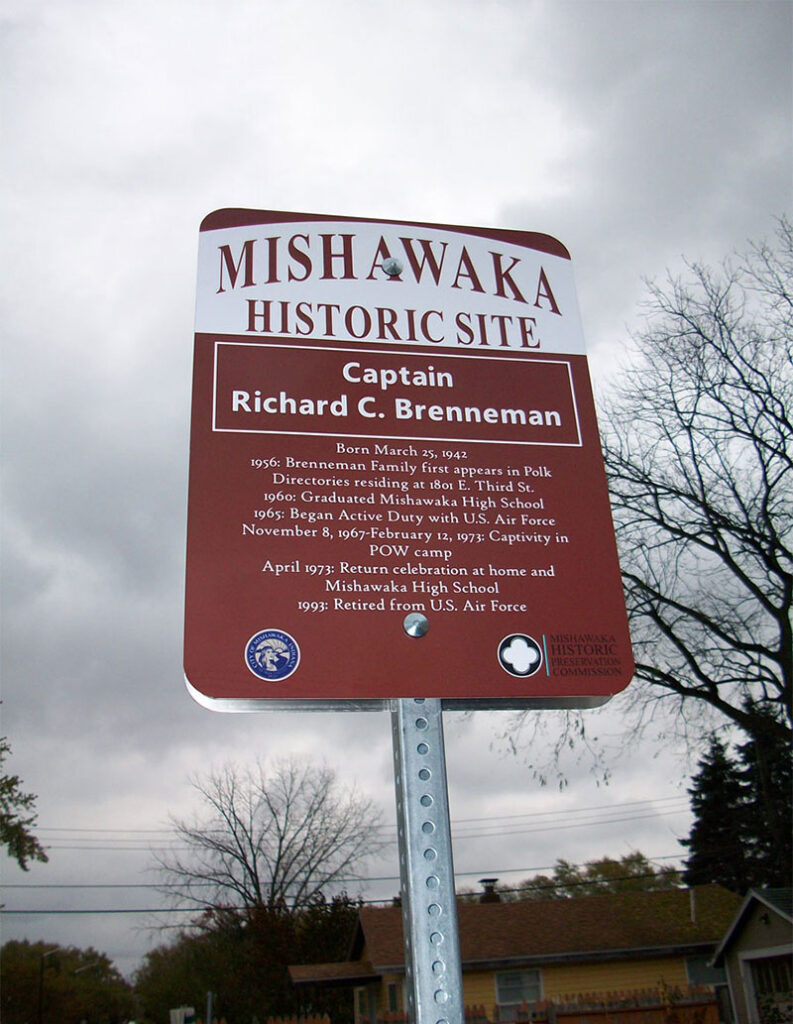
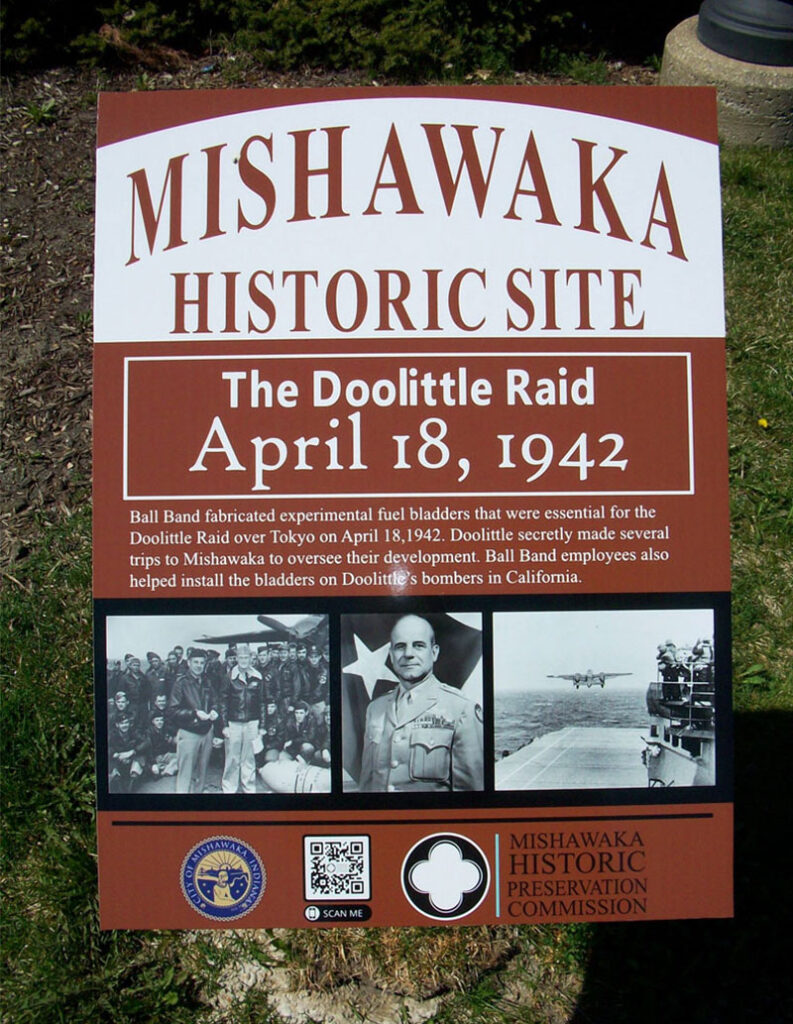
The Doolittle Raid - Southwest corner of Main Street and Mishawaka Avenue
On April 18, 1942, sixteen B-25 bombers launched from the aircraft carrier U.S.S. Hornet tasked with hitting targets in Tokyo and nearby cities. Under the command of Lt. Col. James Doolittle, the Doolittle Raiders carried out the first American attack on Japan. Mishawaka’s Ball-Band plant contributed to the mission’s success. The B-25 bombers were chosen because they could fly off a carrier, but they needed to be modified with extra fuel tanks to have a range of 2,400 miles– enough to launch 450 miles or more east of Japan, strike their targets, and then continue to airstrips in China. For these special fuel cells, the Army Air Corps turned to Mishawaka Rubber & Woolen Company, or Ball-Band. Working around the clock in February 1942, employees designed and built three fuel tanks for each B-25: a 225-gallon bulletproof fuel cell to fit in the bomb bay, a 160-gallon synthetic bladder for the crawlway between the cabin and aft fuselage, and a 60-gallon tank to be stowed in place of the lower gun turret. Lt. Col. Doolittle visited the Mishawaka plant during production, but the purpose for the fuel cells remained top secret. Later, Doolittle sent a telegram to Ball-Band’s employees, congratulating them on their vital role in the raid. The Doolittle Raiders began to turn the tide of war in the Pacific. The nation honors their bravery and sacrifice, and our community also remembers the creative, dedicated Mishawaka factory workers who helped strike this blow for victory against Imperial Japan.
Elijah Powell Family - 109 South Cedar Street
The Elijah Powell family was the most prominent African American family in Mishawaka over a century ago. Elijah was born in Owen County, Indiana, in 1841 and migrated to South Bend in 1857 or 1858. His father, Farrow, became one of the wealthiest black men in the county and a founding member of South Bend’s black community. Elijah volunteered to join the 102nd U.S. Colored Regiment during the Civil War and saw action primarily in South Carolina during 1864 and 1865. Recognized for gallantry, Powell rose to the rank of sergeant before the war’s end. Elijah married Mary Ann Hackley of Niles, and they moved to Mishawaka in 1868. Barbering was Elijah’s skilled trade, and he began 38 years of service to his adopted hometown. The Powells originally lived on South Main Street, but a growing family led them to move to 109 South Cedar sometime between 1890 and 1896. Elijah and Mary Ann eventually had 14 children, and their family formed the heart of Mishawaka’s small black population by 1900. The Powells were highly regarded in Mishawaka and models of successful integration, well known for their responsibility, frugality, and commitment to education. Medora, the oldest child, was the first black graduate of Mishawaka High, Class of 1887. Several of Elijah’s sons became barbers, most notably Otto, who barbered in Mishawaka until his death in 1956. Today, Elijah and Mary Ann Powell have dozens of descendants scattered across the country. Although none lives in Mishawaka, the Powells’ spirit endures, especially as our black population has steadily grown in recent years.
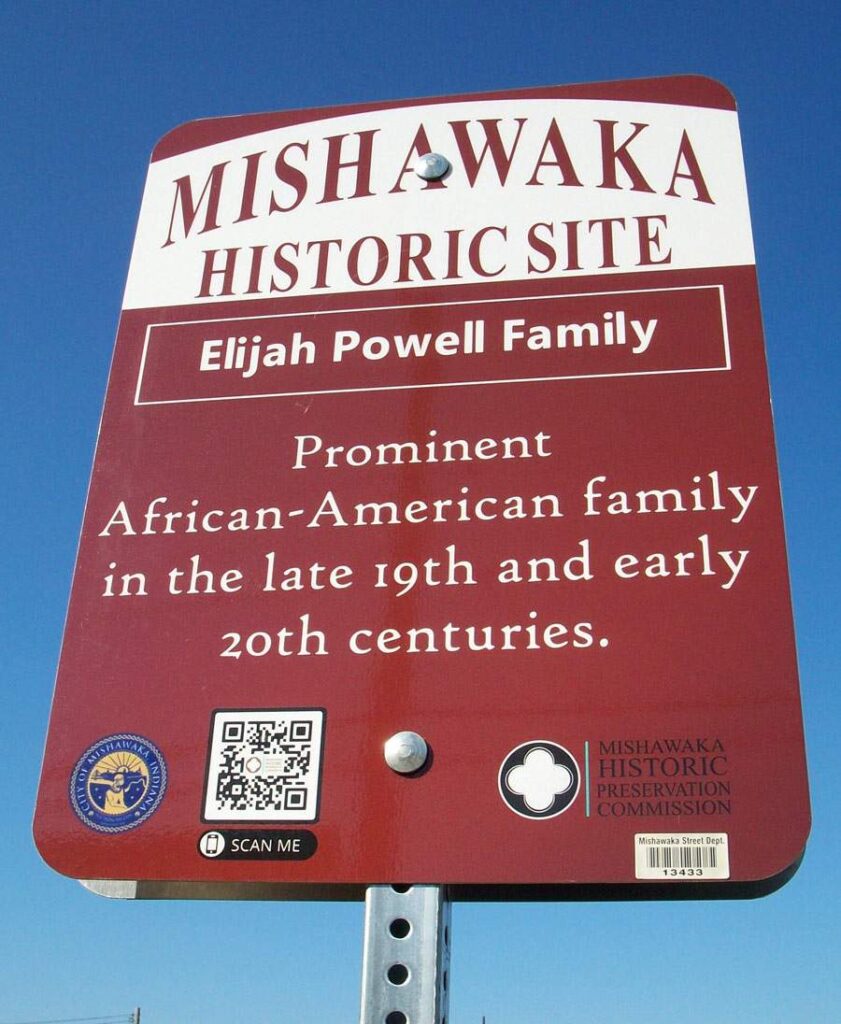
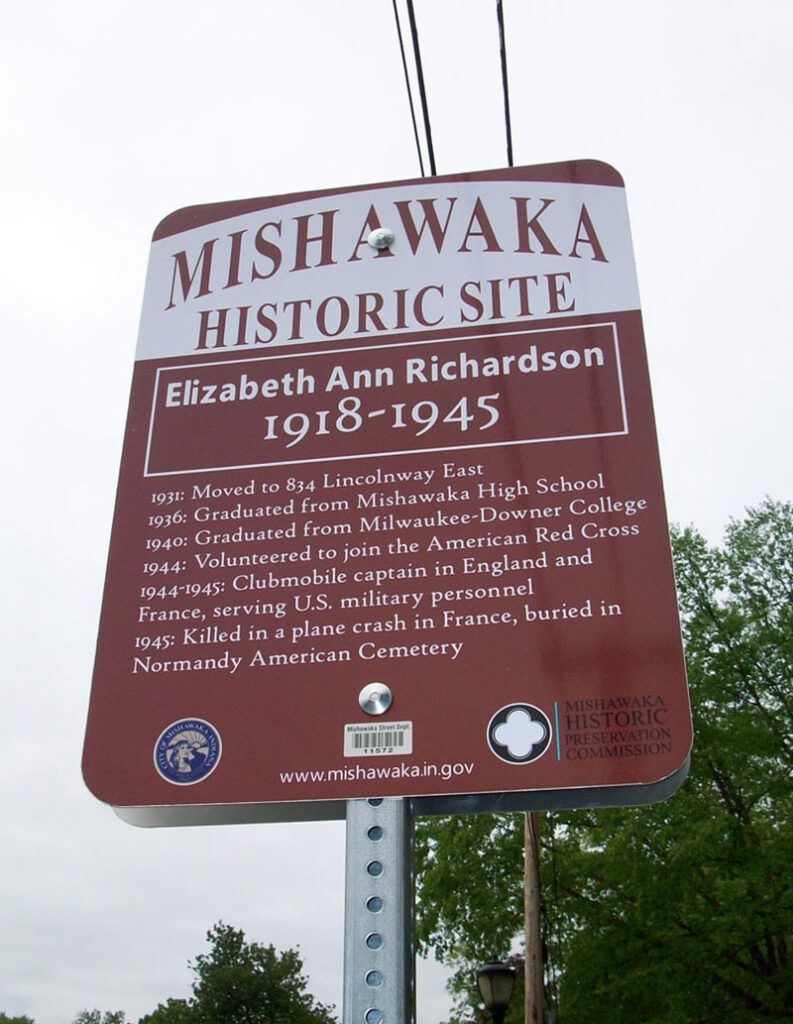
Elizabeth Ann Richardson - 834 Lincolnway East
A war hero unique in Mishawaka history, Elizabeth Richardson served in the American Red Cross and today is the most remembered American woman in uniform killed during World War II. Born in 1918, in Akron, Ohio, Elizabeth was the oldest of three children. Her father was an executive in the rubber industry, and the family came to Mishawaka in 1931 when he was hired by Ball-Band. Richardson graduated from Mishawaka High in 1936 and attended Milwaukee-Downer College, majoring in English and art. Elizabeth was a prize-winning artist in college. After earning her degree in 1940, Liz took an advertising job in Milwaukee. She longed to make a meaningful contribution to the war effort, so she decided to join the American Red Cross in early 1944. After her training in Washington, D.C., Richardson arrived in England in July. She was assigned to a Clubmobile, which was used to reach G.I.’s and build morale at bases outside London. Elizabeth and her comrades often worked twelve or more hours a day “slinging doughnuts,” making coffee, and providing friendly conversation and a reminder of home for the troops. She and her co-workers first traveled to various bases in England and then relocated to Le Havre, France, in March 1945. They served G.I.’s who passed through the port city or were stationed at nearby bases. On July 25, 1945, Liz was killed while on a flight from Le Havre to Paris. She is buried at Normandy American Cemetery.
Freddie Fitzsimmons - 524 West Grove Street
Freddie Fitzsimmons was Mishawaka’s first and only Major League baseball player and the most famous Mishawakan of the twentieth century. He was born on a farm in Tipton County in 1901, and his family moved to Mishawaka around 1905. When Fred was growing up, the family lived in various homes on Grove and Lawrence Streets and on Laurel Street. Fred learned baseball in his neighborhood’s sandlots. Fitz’s professional career began in the minor leagues with Muskegon, where he was a pitcher from 1920-1922. He then played for the Indianapolis Indians from 1922-25. Fitz made his major league debut with the New York Giants on August 12, 1925. Known for his knuckleball, fielding, and competitiveness, Fitzsimmons was one of the top pitchers of the 1920s and ’30s. He twice led the National League in winning percentage and was a 20-game winner in 1928. He pitched in the 1933, 1936, and 1941 World Series and was a member of the Giants’ 1933 World Champions. In 19 seasons, Fred had a career record of 217-146. Fitz was manager of the Philadelphia Phillies from 1943-1945 and later coached for the Braves, Giants, Cubs, Athletics, and several minor league teams. Fitzsimmons died in Yucca Valley, California, in 1979. He was inducted into the Indiana Baseball Hall of Fame in 1992 and the Mishawaka High School Athletic Hall of Fame in 2019. During his playing days, Freddie Fitzsimmons was a household name across the country, and he put Mishawaka on the nation’s sports map.
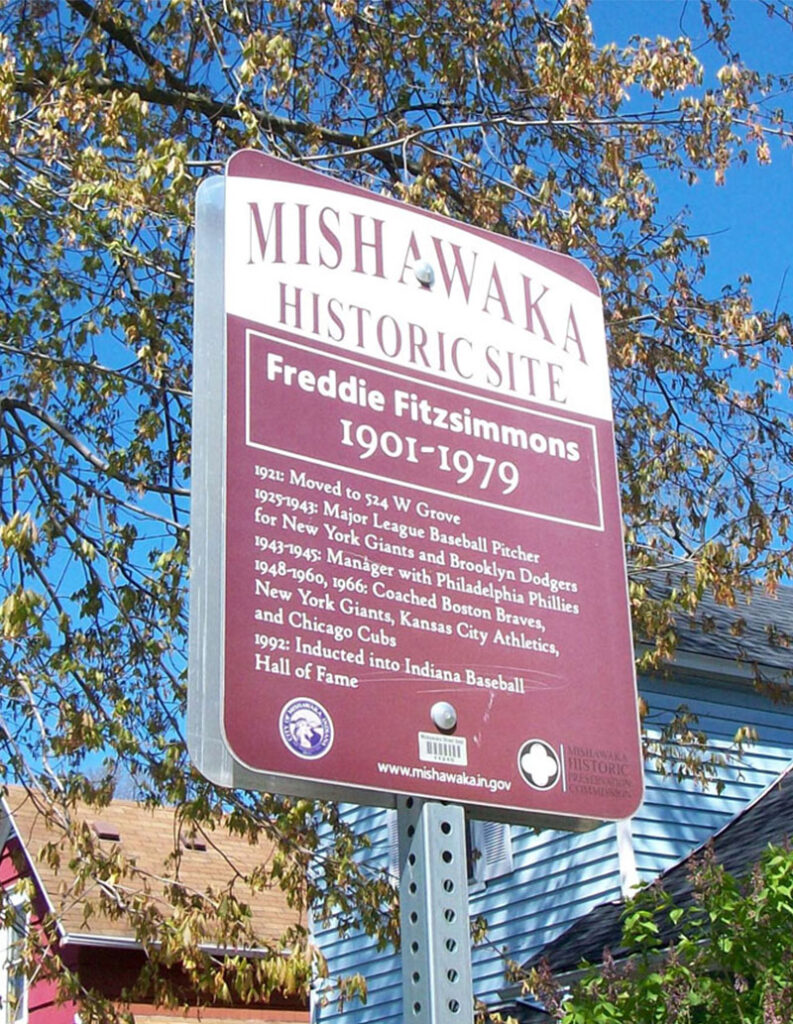
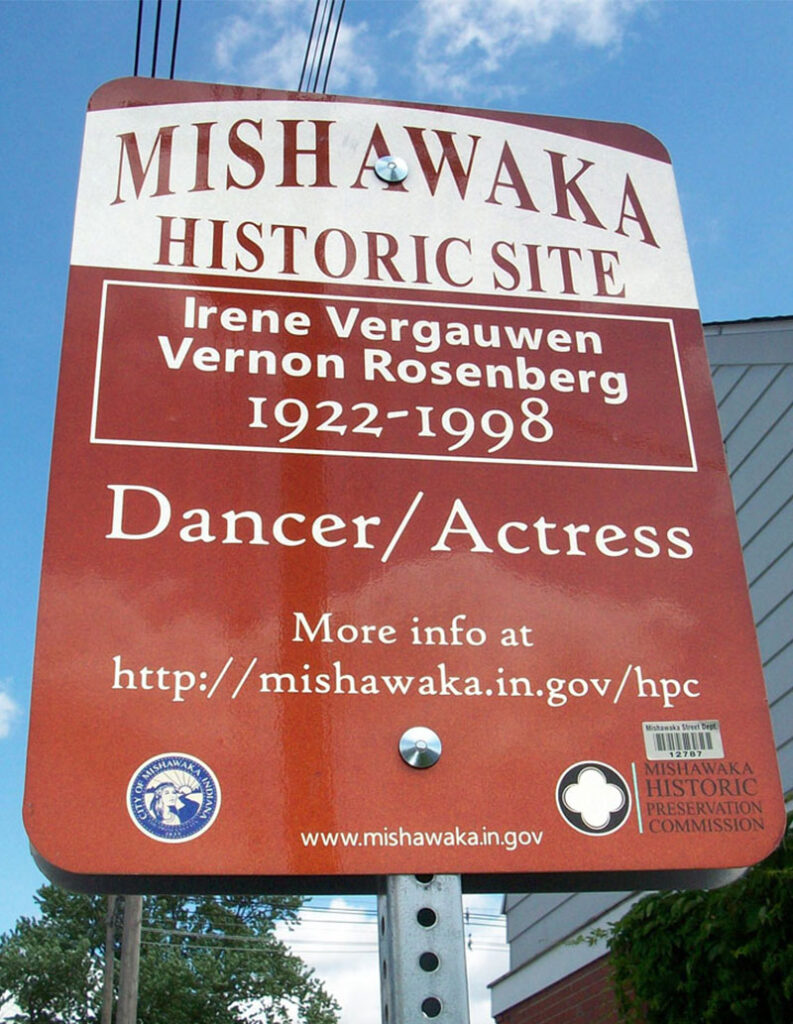
Irene Vernon - 404 South Taylor Street
Born in 1922 to Flemish immigrant parents in the West End, Irene Vergauwen graduated from Mishawaka High in 1939 and soon after went to New York City to be a dancer in night clubs and on Broadway. Using the stage name Irene Vernon, she signed a contract with M.G.M. Studios and had parts in eight Hollywood movies between 1946 and 1960, most notably The Sound of Fury in 1950. Among the stars she appeared with were Jackie Gleason, Frank Sinatra, Judy Garland, Danny Kaye, and Lloyd Bridges. From 1950-1963, Vernon also made 25 guest appearances on numerous television programs, including The Lone Ranger, Fireside Theatre, General Electric Theater, The Donna Reed Show, and Dennis the Menace. Vernon’s most famous role began in 1964 when she was cast as Louise Tate on the popular sitcom Bewitched. Her character was a friend of Samantha Stephens, the witch played by Elizabeth Montgomery, and the wife of Larry Tate, who was Darrin Stephens’s boss. “And Something Makes Three” was the episode that most prominently featured Vernon’s role as Louise, who finds out she is pregnant. After appearing in 13 episodes during Bewitched‘s first two seasons, Irene left the show and began a real estate career in Beverly Hills. In 1990, Vernon moved to Miami Beach, Florida, where, as Irene Vergauwen, she married Emanuel Rosenberg in 1993. After his death in 1997, Irene moved to South Bend, where she died in 1998. Irene Rosenberg is buried in St. Joseph Cemetery.
Remo Belli - 127 West Twelfth Street
Remo Belli was a professional drummer and started a business that became the world’s leading drumhead producer. Remo was born in Mishawaka in 1927. His interest in drums began when he was age 12 and would watch the drummer in his uncle’s band at the DeAmicis Club. Belli was playing professionally at 16. Remo graduated from Mishawaka High in 1945 and, after service in the U.S. Navy, moved to Los Angeles in 1946. He played at prominent venues and with some of the top performers’ traveling bands. In 1952, Belli opened Drum City, which was such an important retail outlet that manufacturers invited him to visit their plants. On one such trip, Belli was introduced to Mylar, a synthetic material that had possible use for replacing calfskin drumheads, which were affected by humidity. Remo and associates patented a system for making Mylar drumheads and opened Remo, Inc. in 1957. He called the product “Weather King.” Sales of Remo products soared, just as rock-and-roll was taking off. Eventually, synthetic drumheads were used in every musical genre, and Weather King became the drumhead of choice. Remo, Inc.’s products caused the standardization of drum sizes around the world. Musicians can now purchase drumheads that fit precisely, regardless of their manufacturer. The early 1980s saw the development of Remo’s “Pre-Tuned” head, a Mylar film stretched on a hoop without other hardware, and Acousticon, a drum shell that sounded like wood but was stronger and more durable. Remo Belli died in Pasadena, California, in 2016.
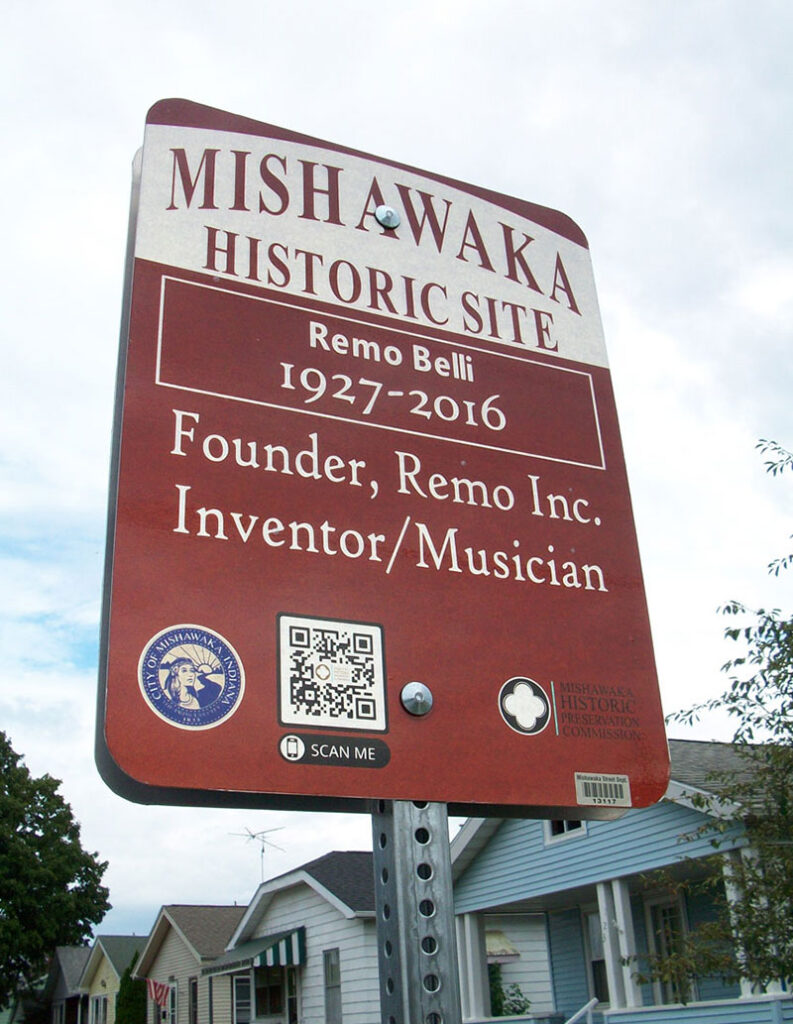
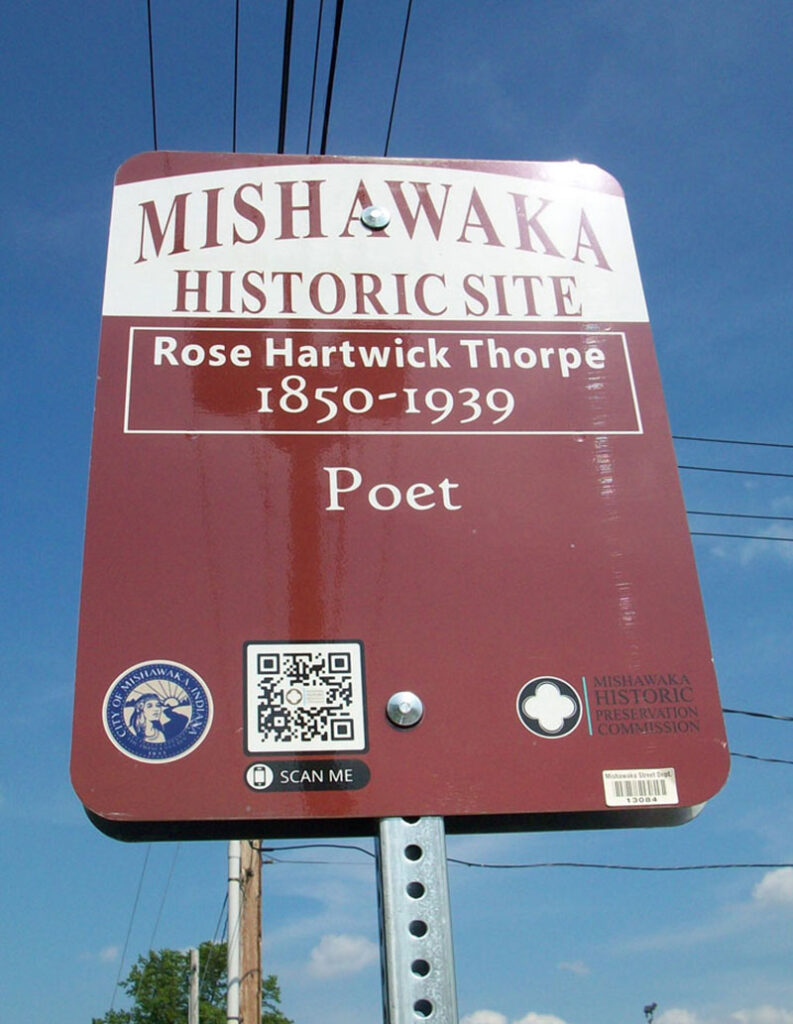
Rose Hartwick Thorpe - 320 East Fourth Street
A Mishawakan who became internationally famous was Rose Hartwick Thorpe. She was born in 1850, lived her first ten years in Mishawaka, and attended the Mishawaka Institute. As a sixteen year old living in Litchfield, Michigan, Rose read a magazine article that inspired her to compose a poem entitled “Curfew Must Not Ring Tonight.” In 1870, Rose submitted “Curfew” to a Detroit newspaper for which she had been writing a poem each week. The poem, set in 16th century England, is about Bessie and her lover, Basil Underwood, who is to be executed at sunset when the church bell rings to signal curfew. To save him, Bessie climbs the ladder of the tower, repeating to herself, “Curfew shall not ring to-night.” She clings to the bell’s clapper so it cannot ring when the sexton pulls the rope, swinging the bell and Bessie soundlessly. Touched with pity by Bessie’s act of sacrificial love, Oliver Cromwell pardons Basil to complete the happy ending. Newspapers around the country reprinted Rose’s work, and it quickly became one of the most popular poems of the 19th century. “Curfew” spread throughout the English-speaking world and was translated into seventeen languages. Rose became an international literary star. Rose married in 1871 and briefly served as the editor of publications devoted to temperance, home life, and Sunday School. She and her husband moved to San Diego in 1887, and Rose continued writing poetry, often on religious and nature topics. Rose Hartwick Thorpe died in San Diego in 1939.
William P. O’Neill - 806 West Mishawaka Avenue
William O’Neill achieved statewide political prominence in the early twentieth century. He was born in 1874 and grew up in South Bend. O’Neill entered the University of Notre Dame at age 13, pursued literary and scientific studies, and graduated at age 17. He established the Mishawaka Democrat weekly newspaper in 1894. William returned to Notre Dame, earned a law degree, and passed the bar, beginning a legal career that would last the remainder of his life. O’Neill became a law partner of Edward Schwab, forming the legal practice of O’Neill & Schwab. William was elected prosecuting attorney in 1900, and, from 1906-1910, he served as Mishawaka city attorney. O’Neill also helped carry out the residential development of Mishawaka through the North Side Land and Improvement Company. O’Neill was elected lieutenant governor of Indiana in 1912 and served four years in this capacity under Gov. Samuel Ralston. As lieutenant governor, he was chairman of the Indiana Commission for the Panama-California Exposition and oversaw development of the fair’s Indiana building. After his term ended, O’Neill resumed his legal practice and later headed the Indiana Securities Commission from 1930-36. William and his wife, Gertrude, built a Classical Revival house at 806 W. Mishawaka Avenue, c. 1908. It remains one of the great landmark homes in the city and has been rated as an Outstanding structure. William O’Neill lived there until his death in 1955. He and Gertrude are buried in St. Joseph Cemetery.
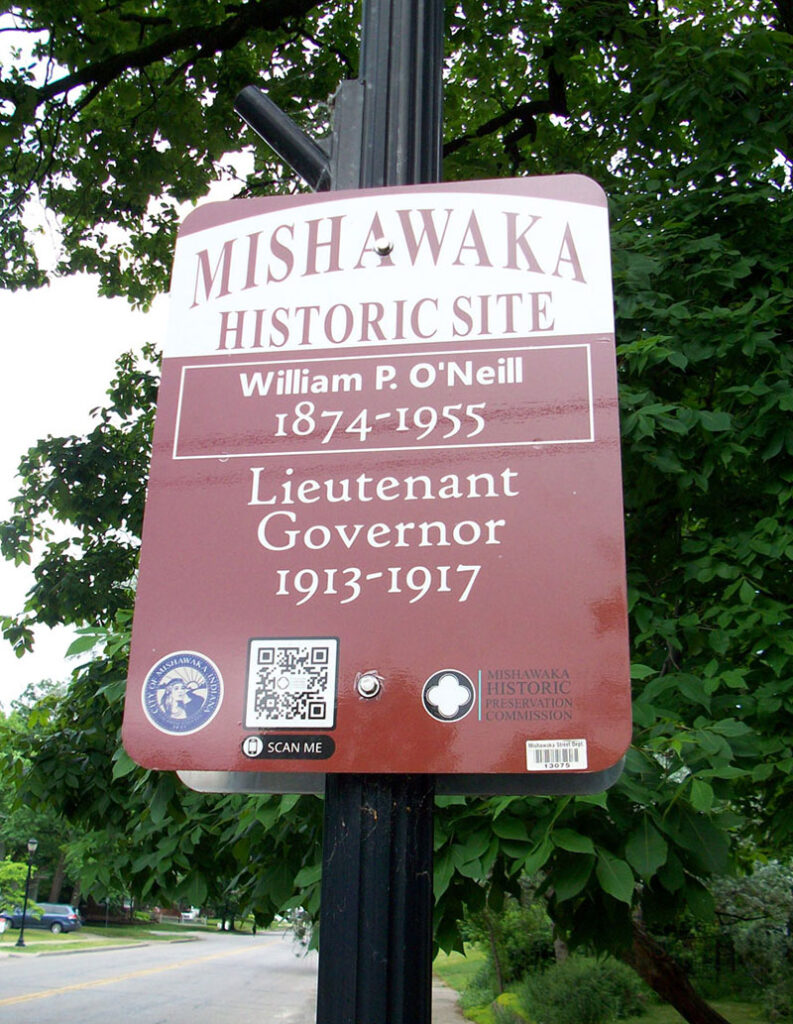
Great Mishawaka Fire of 1872 - South side of the 100 block of Lincolnway West
The Great Mishawaka Fire of 1872 was the most terrifying disaster in the city’s history, destroying a large portion of the downtown on the evening of September 5, 1872. Perfect conditions made a great fire almost inevitable: wood-frame buildings, combustible material such as hay, open flames used for light and cooking, and inadequate firefighting capability. The massive fire that broke out at 7:45 p.m. was also fueled by hot, dry conditions and a strong wind. Southwest of Main and Second Streets stood the Presbyterian Church. Behind it was the parsonage’s barn and, to the south, a barn owned by S.H. Stevens. The blaze likely began in the Stevens barn and was spread by high winds to the parsonage’s barn and then to the church. Fire devoured the block as residents sought vainly to douse the flames with the town’s hand-pump engine. Wind-whipped sparks caused the fire to leap to the downtown’s northwest and northeast blocks. Brave citizens tried extinguishing the blaze, business owners threw goods into the street to avoid losing them in the flames, wagon drivers carted the items to safety or purloined them, and others just gawked as Mishawaka burned. After the smoke cleared, Mishawakans were stunned to see that 49 buildings had been lost. Within a year, 29 brick structures had been built in the downtown, including the aptly named Phoenix Building, which still stands at the southwest corner of Lincolnway West and South Main Street, just feet from where the devastating fire began.
Margaret Prickett - 2006 Linden Avenue
Margaret “Maggie” Prickett is the most significant woman in Mishawaka’s history. Maggie was born in Mishawaka in 1908. A 1926 graduate of Mishawaka High, she married Ward Prickett in 1929, and they opened a grocery store in Twin Branch the next year. The Pricketts ran their business together while also raising three daughters. After Ward died in 1955, Mrs. Prickett managed the store and expanded it into a supermarket. Maggie ran for mayor in 1963 and defeated incumbent Joseph Canfield, making her Mishawaka’s first woman mayor and only the third woman to be elected mayor in Indiana. Mrs. Prickett served a then-record four terms from 1964-1980. Known for her strong will, pride in Mishawaka, and love for her fellow citizens, Mayor Prickett’s greatest achievement was attracting developers of University Park Mall by extending utilities into farmland that was far north of the city limits, a decision that spurred the development of Mishawaka’s north side. She also created the Emergency Medical Services department, moved the police department into a new headquarters, and negotiated for a Mishawaka interchange on the Indiana Toll Road. Under Mayor Prickett, the city’s parks prospered with the addition of several parks and construction of the Merrifield Park pool and ice rink. The development of Shiojiri Garden and lighting for softball diamonds at Central, Rose, and Twin Branch Parks also occurred. Mrs. Prickett was defeated during her bid for a fifth term in 1979. Maggie Prickett died in 2003 and is buried in Fairview Cemetery.
